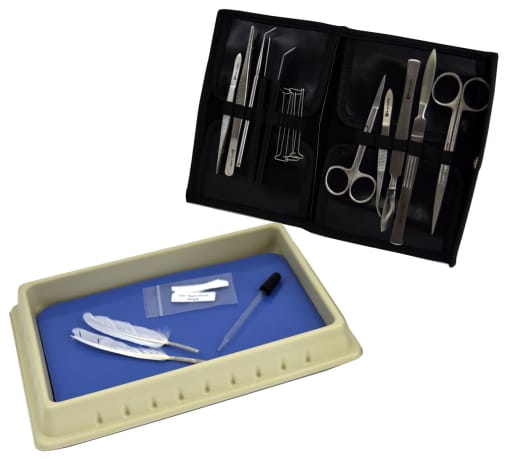This kit from Nature's Workshop Plus, provides all the necessary items to complete the dissection labs. Included are PTC paper strips (15), feathers (2), dissection tools and tray, and 4 specimens (earthworm, crayfish, perch, and frog). Preserved specimens are vacuum packaged individually. Refrigeration is not required. May be stored up to one year at room temperature.
Discovering Design with Biology, Dissection Kit - EPS
Description
This kit contains all the items needed for the dissection experiments contained in Discovering Design with Biology.
The specimens can be stored at room temperature for one year.
Items included
- 15 PTC paper strips
- Two feathers
- Dissection tools
- Dissection tray
- Earthworm specimen
- Crayfish specimen
- Perch specimen
- Frog specimen
Building biology from the ground up, this creation-based approach to science introduces students to the characteristics and organization of life, the scientific method, and the chemistry of life before building upon cell theory and division. Once the foundations are laid, genetics (Mendelian and non-Mendelian), biotechnology, single-celled organisms and fungi, animals, human anatomy and physiology, plants, environmental science, and ecosystems are taught. The authors take a conversational approach, so students will find more reading and fewer pictures compared to other curricula. This sets students up for success, even for families without a strong science background.
A full lab experience is integral to this program. There are a total of 38 experiments that will take a minimum of 40 hours to complete. Labs are divided into three types: Household, Microscopic, and Dissection. Students must complete the Household experiments, and either the Microscopic or Dissection labs minimally for a full lab credit. Labs have been written for home use with complete supply lists and easy step-by-step instructions. Basic information to keep a lab notebook are included, with expanded instructions found on the author's website. If choosing to complete the microscopic labs, a microscope with 40/100/400x magnification and coarse/fine focus knobs are required. Optional lab kits are available. See individual descriptions for more information.
Since this course is streamlined for homeschoolers, there are two required components, and numerous supplemental options for student success. The core instruction is found in the hardcover textbook. Along with the appealing narrative writing style, the text includes comprehension and review questions, lab instructions, and answers to the comprehension questions. The text is divided into sixteen chapters, with a suggested 2-week schedule to complete each module. The front of the text gives general schedule guidance, which allows for flexibility to meet your homeschool needs. Conveniently, the appendix includes a daily assignment checklist which follows a 36-week schedule. It is expected that students will need to dedicate one hour per day, 5 days per week to complete the course in one year. Also included in the appendices are reference tables and charts, and experiment supplies by chapter. Purchase of the textbook includes a link to a website with helpful resources including video explanations or experiments (different than the text experiments), sample lab write-ups, an errata sheet, and access to a question-and-answer service with co-author, Dr. Jay Wile. This is a good place to mention that Dr. Wile chose to work with Dr. Paul Madtes, Jr. in this text. Dr. Madtes actively teaches biology at the university level and has a vision to successfully prepare high schoolers for the challenge of college level biology courses. Along with the college preparatory focus, Dr. Madtes endeavors to keep students focused on the Creator and begins each chapter with Scripture. There is no math requirement, other than students being on level in their math abilities.
Typically, students take algebra concurrently with biology. The softcover Answer Key & Tests Book includes reproducible tests and answers, chapter review answers and grading/testing tips. These required components are sold individually or in a package.
If you were to compare this to the Apologia Exploring Creation with Biology, 3rd edition, you will notice that there are fewer illustrations, and a more narrative text. Both courses prioritize a biblical worldview and teach college preparatory content. This course does include one chapter on anatomy and physiology, which is not included in the Exploring Creation with Biology text. Both texts incorporate three types of labs (household, microscopic and dissection); however, Discovering Design with Biology recommends completing two out of three types of experiments for a full lab credit, while Exploring Creation with Biology requires all three be completed for the full lab credit. Other differences are the available teacher/student supports and the fact that the Discovering Design with Biology textbook is hardcover.
Beneficial, supplemental resources include USB Audiobooks, Student Workbook, Lab Kits, and a supplemental reading list for students who want to learn more. See each individual item for more detail. ~Deanne
| Product Format: | Other |
|---|---|
| Grades: | 9-10 |
| Brand: | Nature's Workshop |
| Length in Inches: | 10.5 |
| Width in Inches: | 13.25 |
| Height in Inches: | 5.25 |
| Weight in Pounds: | 2.6 |

